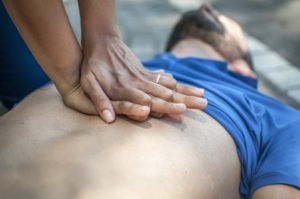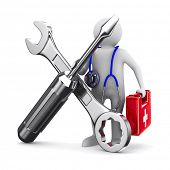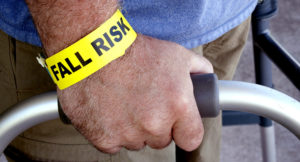What does cardiopulmonary resuscitation mean (CPR) ? Resuscitation is a vital emergency technique for the restoration of life or consciousness of the person whose respiration and cardiac activity have ceased
What does cardiopulmonary resuscitation mean and the importance of CPR !
Cessation of respiration and cardiac activity results in cessation of oxygenation of blood and pumping of the oxygenated blood to tissues. Since oxygen is essential for survival, resuscitation is done to reestablish tissue oxygenation until respiratory and cardiac functions are restored.
The ABC of cardiopulmonary Resuscitation
Sign Function
A Clear the Airway
B Restore Breathing
C Restore Circulation
How to clear the airway while resuscitating ?
Clear airway by keeping the head tilted back and sweeping a finger around the mouth. The airway may be blocked in an unconscious patient due to loss of cough and gag reflexes. That allows the tongue to sag back and block the airway.
Mucous or foreign bodies like regurgitated solid food particles may also block the airway. That makes breathing difficult and noisy. Airway is cleared as follows.
Use the index finger to hook out any material in the mouth and pharynx, such as broken teeth, vomit, broken dentures, foreign body or mucous. Also, remove constrictions around the neck, if any.
Hyper extend the neck by placing one hand under the neck and the other hand on forehead to tilt the head back. Lift the chin forwards. That pulls the tongue forwards and opens the airway at the back of the throat and he may restart breathing soon. Put him in recovery position and stay with him.
How to restore breathing while doing cardiopulmonary resuscitation ?
Mouth to mouth ventilation (Kiss of Life)
After the airway is cleared, listen for five seconds with your ear close to the victim’s nose and mouth. If breathing has not been reestablished, perform mouth to mouth breathing by the following technique.
Put the person on his back and tilt the head back as far as possible (nostrils then point directly upwards at you). Cup one hand under his chin and put the heel of the other hand on his forehead so that the fingers of that hand can pinch his nose.
Use both hands together to leen the head back and pinch and compress nose to close nostrils. Make sure the person’s mouth is open and take a deep breath. Place your mouth over the victim’s mouth, making an airtight seal.
Breathe into victim’s mouth firmly and quickly, taking quick breaths in between to refill your own lungs with fresh air. Allow patient to exhale passively by elastic recoil of his chest between two breaths.
Try to ‘blow’ a breath into the patient about every six seconds. Be guided by common sense on this. For example, the first few breaths can be given much quickly to try to get some oxygen into the patient.
Stop when the patient shows clear signs of starting to breathe but even then keep a close eye on his chest movements until professional help arrives.
Some useful hints for CPR
Don’t blow too hard as this may send air into the stomach and make the person vomit, which is dangerous for him and unpleasant for you. Should he vomit, turn his head to one side and let the vomit dribble out of his mouth. Clean out the mouth and carry on with resuscitation.
If a child is the victim, seal your lips over both nose and mouth after positioning the head as before. Only blow gently. Be guided by what procedures a rise and fall of the chest wall. In babies, use only the amount of air you can hold in your cheeks – don’t blow from your lungs.
If the abdomen starts swelling up, you’ll know you’re blowing air down the gullet into the stomach instead of down the windpipe.
Stop resuscitation for a moment, turn the child to one side, press firmly over the swollen stomach. This will probably force the air out. Check that the person’s heartbeat hasn’t stopped by feeling in the neck for the carotid pulse from time to time.
How long to continue cpr ?
Either until the person starts to breathe easily again. Never try breathing into someone who is already breathing spontaneously. It can be helpful though to give the odd helping breath if he is gasping or breathing irregularly.
Or until professional help arrive. This may take time, so get others to help you. Keep going until a doctor says the person is dead. Don’t give up too readily, especially in cases of drowning or electric shock.
Mouth to nose ventilation
Mouth to nose ventilation has to be used in situations such as mouth injuries making a good seal impossible or rescue from water.
With the victim’s mouth closed, from a tight seal with your lips around the victim’s nose. Breathe into his nose four times quickly and open the mouth to let the breath out after every breath in.
Watch victim’s chest movement for rise and fall of chest with each breath to confirm adequacy of your ventilation. If the chest does not rise, check that your have a firm seal around the victim’s nose and you have close the mouth completely.
Manual methods of Artificial Ventilation
In certain situations, mouth to mouth respiration cannot be given e.g. when the face is damaged, the lower jaw is fractured, or the lips and mouth have been burned by a poison. In such cases, manual methods are used.
Hip lift back pressure method
Place the victim face down, forehead resting on the back of the uninjured hand. Keep the head straight and straddle the patient at the level of his hip, placing one knee and the other foot on the ground. Then bend forwards and catch the bony pelvis with both hands.
Bend backwards keeping the upper limbs straight, such that the hips are lifted 10-15 cm above the ground, while you count one-to-three. Lower the hips to the ground and slide the hands to the middle of the back just up to the tips of the shoulder blades, fingers spread and thumbs near midline, as you count four.
Rock forwards keeping your upper limbs straight so as to apply pressure till resistance is felt. Count five-six-seven. Release the pressure gradually and slide the hands back beneath the hips again as you count eight and repeat the whole process 10 times a minute.
Arm-lift / chest pressure method (Silvester)
Place the patient face upwards and place a folded blanket under his shoulders to raise them so that the head falls backwards.
Kneel near the head and grasp his forearms near his wrists, cross them over to the lower part of the chest and then lean forward to press the crossed arms for 2 seconds.
Then pull the arms upwards and outwards with a sweeping movements and place them on the ground by your own knees for 3 seconds.
Repeat the cycle 12 times a minute. This method is useful when the victim cannot be placed face down. It is more effective than the prone pressure method.
How to restore circulation while doing cardiopulmonary resuscitating ?
Precordial thump is the first measure to be taken except for patients known to have myocardial disease. Make a sharp thump over the midsternal region with a closed fist. It may restore normal cardiac activity especially in electric shock cases.
External cardiac massage is given if precordial thump fails to restore normal cardiac activity. Its technique is as follows.
Place victim on a hard surface. Kneel by his side and place heel on one hand over the sternum 1-2” above xiphoid process. Then place the other hand on top of it and interlock fingers so as to keep them off the victim’s ribs.
Gradually compress downwards making full use of your body weight to depress victim’s sternum by 1.5 to 2” and relax pressure completely without lifting your hands from the victim’s so as not to lose correct hand position.
Repeat all steps.
After every 15 chest compressions give 2 quick lung inflations by mouth-to-mouth breathing. Also, if there are two person giving first aid, one person can give the external cardiac massage, while the other gives the artificial ventilation. It is necessary to stop the cardiac massage when the ventilation is done.
RELATED TOPICS
Personal injury lawyers in Austin
Online medical assistant schools


